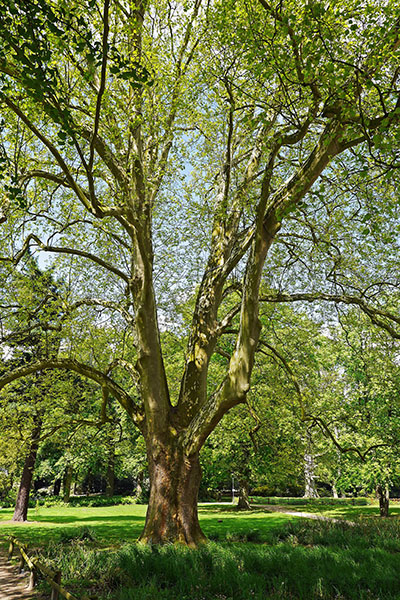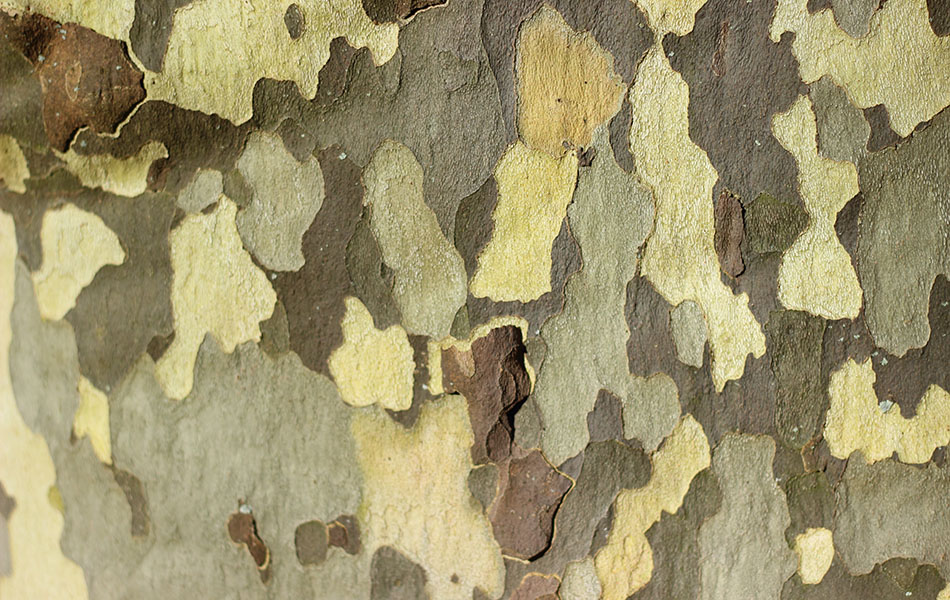The American Sycamore at a Glance
 Botanic name: Platanus occidentalis
Botanic name: Platanus occidentalis
Family: Platanaceae (Plane tree)
Common names: Eastern Sycamore, American Plane Tree, Plane Tree, Buttonwood Tree
Hardiness: Zones 4 through 7
Shape: Pyramidal when young, with crown becoming round and more irregular at maturity
Size: 75’-100’ tall, with a crown spread nearly as wide
Sun: Full sun, will tolerate some shade
Bark: American Sycamore has striking, exfoliating bark that exposes layers of brown, green, and white bark in a jigsaw-like pattern
Foliage: Large, medium-green leaves in a 3-lobed, palmate form that resembles a maple. Leaves turn golden brown in fall.
Flowers: Male and female flowers appear on the same tree, making it self-fertilizing. Tiny flowers are red or yellow, not showy, and bloom in spring
Fruit: Sycamore fruits are achenes, dry spheres that retain their seeds. Mature fruits are about 1.5” in diameter and form a ball that dangles at the end of a stalk and it attractive to birds. Along with its bark, sycamore fruit is an important tree ID clue.
Uses: Sycamore wood is used for furniture, veneers, barrel making, and as fuel. Historically, Native Americans used sycamore trunks to fashion dugout canoes.
Scroll to the end of this article for a video showing the features of this beautiful landscape tree.

Close-up of the beautiful mottled bark on an American Sycamore
Overall Description
The American Sycamore is among our largest deciduous trees; you’ll find them among the species in New Jersey’s official Big Trees Registry. Sycamores are fast-growing trees that develop an enormous trunk and a large, spreading crown with an open habit and crooked branches. The American Sycamore’s trunk circumference is among the largest of our native hardwood tree species.
The sycamores’ large leaves, open crown, and patches of white bark create a particularly attractive dappled shade. After leaves drop in fall, the sycamore’s pale-barked branches stand out, particularly when festooned with their dangling, brown fruit. As these trees age and become less flexible, their mottled bark exfoliates less and becomes a more uniform, shaggy brown.
Thanks to their spreading crown, sycamores make excellent shade trees. Their size, however, makes them too large for general use as a street tree, as does their intolerance of saline soils. American Sycamores should be planted where they have plenty of room to reach their full size without excessive pruning and where they will not interfere with power lines or structures.
This sycamore is not suggested for planting in lawns, as its large crown will prevent grass from growing beneath it.

Ripe fruit hanging from the branches of a mature American Sycamore in fall
Preferred Growing Conditions
The native range of the American Sycamore is in low-lying, moist areas such as riverbanks and flood plains. It grows from Maine south to Florida and west to Iowa, Texas, and mountainous areas of northeastern Mexico.
Sycamores prefer rich, moist soil that drains well, with a slightly acidic pH. As their native range is near streams and rivers where the soil is consistently moist, the American Sycamore is classified as somewhat drought tolerant but is not suggested for dry or excessively fast-draining soils or in sites with hot, dry afternoon sun. Sycamores will tolerate clay soil and some urban pollution, as well as black walnut juglone (a toxic substance excreted by black walnuts that kills most other plants growing near it).
Pests & Diseases Affecting American Sycamore
Sycamore anthracnose (Apiognomonia veneta) is a significant disease that can cause premature leaf drop, as well as leaf and twig damage. Leaf damage from anthracnose varies: young leaves wilt and drop while older leaves develop brown cankers along a leaf’s main veins. Heavily infected leaves crumple and droop and you may see trees with portions of their crown bare during the growing season. In response, the sycamore may put out several rounds of new leaves to replace the infected leaves that die and drop to the ground.
Other diseases include leaf spot and powdery mildew, both of which can disfigure or kill leaves.
Pests of the American Sycamore include borers, scale, Japanese beetles, caterpillars, and mites.
American Sycamore Video
GET THE LATEST NEWS
Subscribe to the Organic Plant Care Newsletter and get timely and helpful tips and updates monthly.
There's no spam - we promise!





